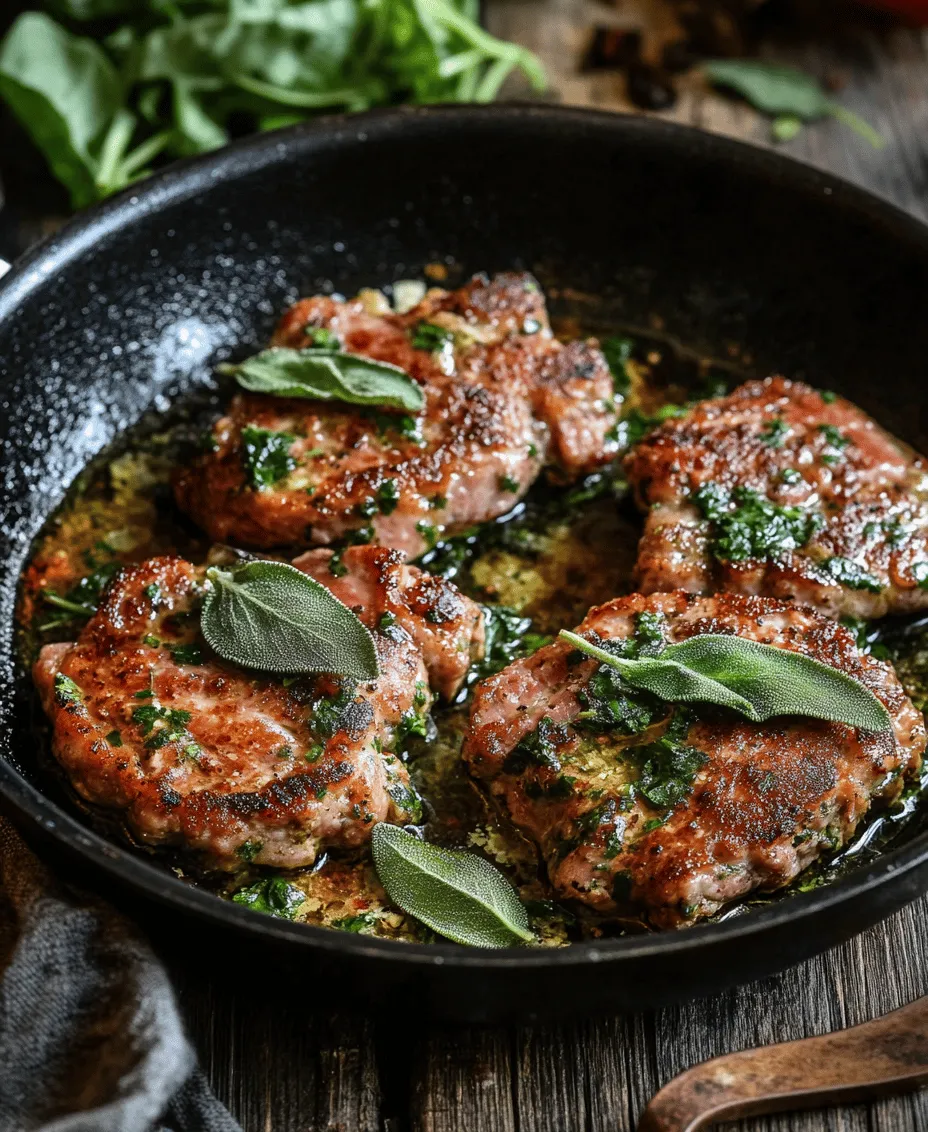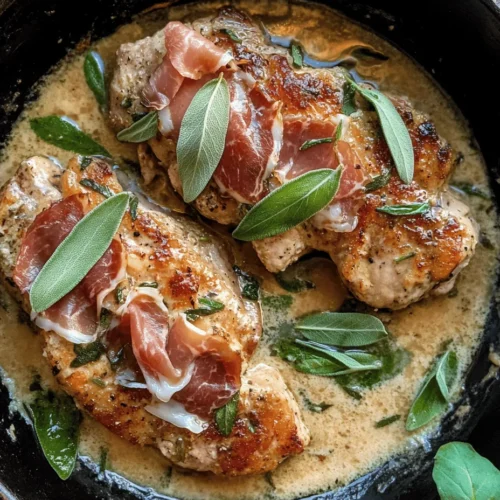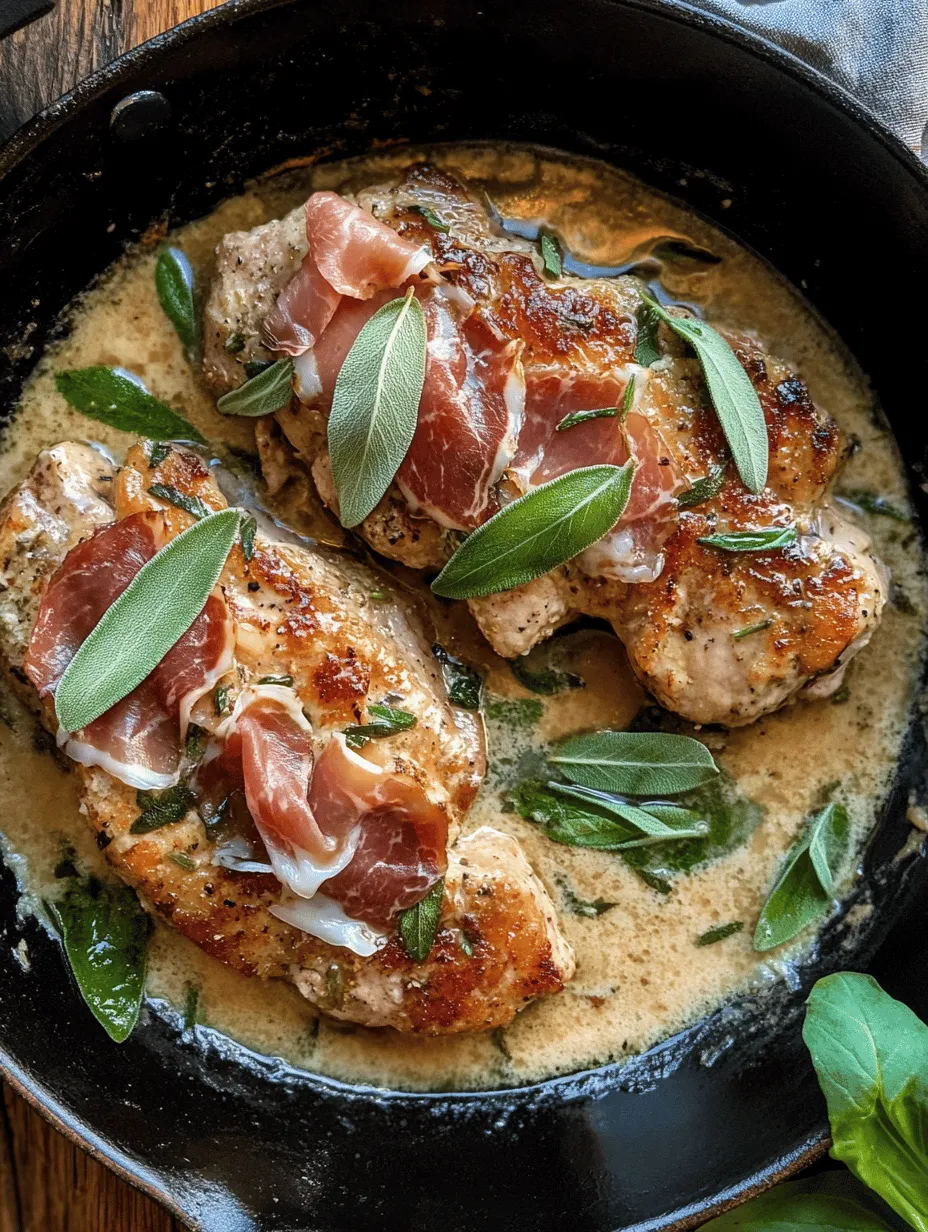Introduction
Saltimbocca Alla Romana is a quintessential dish that embodies the heart and soul of Italian cuisine. Originating from Rome, this traditional recipe showcases the rich culinary heritage of the region, offering a delightful combination of flavors that has made it a beloved choice among food enthusiasts. The name “Saltimbocca” translates to “jump in the mouth,” a fitting description for this dish, which features tender veal cutlets layered with savory prosciutto and aromatic sage, creating a symphony of tastes that dance on the palate.
The significance of Saltimbocca Alla Romana goes beyond its delicious flavor profile; it represents the simplicity and quality of Italian cooking. Using just a few high-quality ingredients, this dish exemplifies how the right combination can elevate a meal to something extraordinary. The marriage of veal, prosciutto, and sage creates a harmonious blend that not only honors traditional Roman cooking but also reflects the broader Italian philosophy of minimalism in the kitchen, allowing each ingredient to shine.
Understanding Saltimbocca Alla Romana
To fully appreciate Saltimbocca Alla Romana, it’s essential to understand its name and the historical context that surrounds it. The term “saltimbocca” is derived from the Italian words “saltare,” meaning “to jump,” and “bocca,” meaning “mouth.” This playful name captures the dish’s essence, suggesting that the flavors are so enticing they seem to leap directly into one’s mouth.
Historically, Saltimbocca Alla Romana has roots that trace back to the Roman countryside, where it was a popular meal among locals and travelers alike. Over the years, the dish has evolved, with regional variations emerging across Italy. While the classic version remains centered around veal, prosciutto, and sage, other interpretations may incorporate different meats, such as chicken or pork, or even substitute the prosciutto with different cured meats, showcasing the versatility of this beloved dish.
Variations of Saltimbocca Across Italy
As with many traditional dishes, Saltimbocca has inspired a variety of adaptations based on local tastes and ingredients. In Lombardy, for instance, you may encounter “Saltimbocca alla Milanese,” which often features chicken instead of veal. In other regions, cooks may choose to incorporate additional ingredients like cheese or different herbs, further diversifying the dish’s appeal. Despite these variations, the core essence of Saltimbocca remains intact: a focus on high-quality ingredients and a celebration of flavor.
Ingredients Breakdown
To recreate the authentic taste of Saltimbocca Alla Romana, it’s crucial to understand the role of each ingredient. Here’s a detailed breakdown:
Veal Cutlets
The foundation of Saltimbocca Alla Romana is, of course, the veal cutlets. When selecting veal, quality is paramount. Opt for fresh, high-quality veal that is pale pink in color, with a fine grain and minimal fat. The cutlets should be thinly sliced to ensure quick and even cooking. The thickness of the cutlets is critical; they should be about 1/4 inch thick to achieve tenderness without overcooking. If necessary, you can use a meat mallet to pound the cutlets gently, ensuring they reach the desired thickness while maintaining their integrity.
Prosciutto
Next is the prosciutto, a key component that adds a rich, savory flavor to the dish. When choosing prosciutto, look for high-quality varieties, preferably from Italy, such as Prosciutto di Parma or Prosciutto di San Daniele. These types are known for their delicate, sweet flavor and melt-in-your-mouth texture. The thinly sliced prosciutto should be layered on top of the veal cutlets, providing a salty contrast to the meat’s mildness.
Sage Leaves
Sage is another essential ingredient in Saltimbocca Alla Romana. The aromatic properties of fresh sage leaves elevate the dish, imparting an earthy and slightly peppery flavor that complements both the veal and prosciutto. While fresh sage is preferred for its robust flavor, dried sage can be used in a pinch, though it may not provide the same depth of aroma. When using fresh sage, ensure the leaves are vibrant and fragrant, as this freshness is critical in enhancing the overall taste of the dish.
White Wine
White wine plays a crucial role in the cooking process, adding acidity and depth to the dish. A dry white wine, such as Pinot Grigio or Sauvignon Blanc, is typically recommended for Saltimbocca Alla Romana. The wine not only deglazes the pan, allowing the flavors to meld, but it also contributes to the sauce that accompanies the cutlets. When selecting a wine, choose one that is drinkable, as the quality of the wine will directly impact the final flavor of the dish.
Butter and Olive Oil
Butter and olive oil are used for cooking the veal cutlets, contributing to the dish’s richness and flavor. A combination of the two is ideal, as the olive oil provides a higher smoke point, while the butter adds a creamy, luxurious finish. When cooking, ensure that the fat is hot enough to achieve a perfect sear on the veal without burning.
Seasoning and Balance
Lastly, seasoning is vital in bringing the dish together. While the prosciutto is naturally salty, additional seasoning may be necessary, depending on personal preferences and the specific brands of ingredients used. A pinch of black pepper can enhance the flavors without overpowering them. The balance of flavors — salty prosciutto, tender veal, and aromatic sage — is what makes Saltimbocca Alla Romana a truly memorable dish.
Preparation Steps Explained
Now that we’ve covered the essential ingredients, let’s delve into the preparation steps for creating perfect Saltimbocca Alla Romana.
Preparing the Veal Cutlets
The first step in preparing Saltimbocca is to ensure that the veal cutlets are properly prepared. Begin by placing the veal cutlets between two sheets of plastic wrap or parchment paper. Using a meat mallet or rolling pin, gently pound the cutlets until they reach a thickness of about 1/4 inch. This step is crucial for achieving tender meat that cooks quickly and evenly. Be careful not to over-pound the cutlets, as this can cause them to become tough.
Layering Technique
Once the cutlets are the correct thickness, it’s time to layer the prosciutto and sage. Begin by laying a slice of prosciutto over each veal cutlet, ensuring that it covers the surface evenly. Next, place a few fresh sage leaves on top of the prosciutto. The placement of the sage is essential; it should be positioned in such a way that it melds with the flavors of the meat and prosciutto during cooking. The goal here is to create a flavor profile that is cohesive and balanced.
Securing Methods
To prevent the layers from separating during cooking, it’s important to secure the prosciutto and sage to the veal cutlets. There are two common methods for this: using toothpicks or kitchen twine.
Using toothpicks is a straightforward approach; simply insert one or two toothpicks through each cutlet to hold everything in place. This method is quick and effective, allowing for easy removal post-cooking. However, be cautious not to let the toothpicks touch the pan, as they can burn.
Alternatively, using kitchen twine offers a more traditional approach. Wrap the twine around the cutlets to secure the layers securely, tying a knot to keep them in place. This method can be a bit more time-consuming, but it ensures that the cutlets maintain their shape during cooking.
Cooking Techniques for Perfect Saltimbocca
Once the cutlets are prepared and secured, it’s time to move on to the cooking techniques that will bring your Saltimbocca Alla Romana to life. The key to achieving a perfectly cooked dish lies in the searing process.
Searing
Begin by heating a generous amount of olive oil and butter in a large skillet over medium-high heat. Once the fat is hot and shimmering, carefully add the veal cutlets to the pan, ensuring not to overcrowd the skillet. The cutlets should sizzle as they make contact with the pan, forming a beautiful golden crust. Sear the cutlets for about 2-3 minutes on each side until they are evenly browned and cooked through.
The secret to a successful sear is patience; avoid moving the cutlets around too much, as this can hinder the browning process. Once they are golden and cooked to your liking, remove the cutlets from the skillet and set them aside to rest briefly.
In the next section, we will explore finishing techniques and how to create a delicious sauce to accompany your Saltimbocca Alla Romana, enhancing the dish even further. Stay tuned for the continuation of this culinary journey through one of Italy’s most cherished recipes.

The Science Behind Achieving a Golden Crust
Creating the perfect golden crust on your Saltimbocca Alla Romana is not just about technique; it involves understanding the science behind cooking meat. The Maillard reaction is the key process that occurs when proteins and sugars in the meat are exposed to high heat, resulting in the desirable browning and flavor development that we associate with a well-cooked dish.
To achieve this beautiful crust, it’s essential to ensure that your meat is dry. Pat the veal cutlets with paper towels before cooking to remove excess moisture. Additionally, using a hot skillet is crucial. Preheat your skillet over medium-high heat before adding oil. This technique helps to sear the meat quickly, locking in flavors and moisture while developing that golden exterior.
Recommended Skillet Materials for Best Results
When it comes to cooking Saltimbocca Alla Romana, the choice of skillet can significantly influence the outcome. Opt for a heavy-bottomed skillet, such as cast iron or stainless steel, as these materials retain heat well and distribute it evenly.
– Cast Iron Skillets: Known for excellent heat retention, cast iron skillets provide a great sear and are ideal for achieving that golden crust. They also add a rustic feel to your dish.
– Stainless Steel Skillets: These skillets provide a non-reactive surface ideal for deglazing, which we’ll discuss shortly. They are also easy to maintain and can go directly from stovetop to oven.
Whichever skillet you choose, make sure it’s large enough to accommodate all the veal cutlets without overcrowding. Overcrowding can cause the temperature to drop, preventing the desired browning.
Deglazing
Deglazing is a crucial step in enhancing the flavor profile of your Saltimbocca Alla Romana. After searing the veal, you will notice a buildup of browned bits on the bottom of your skillet—these are known as fond. They are packed with flavor and will elevate your dish when incorporated into your sauce.
Explanation of the Deglazing Process and Its Importance in Flavor Development
To deglaze, simply add a liquid to the hot skillet after removing the meat. Common choices for deglazing include white wine, broth, or even a splash of vinegar. The liquid will begin to bubble and steam, loosening the fond from the skillet.
Deglazing not only helps to incorporate the rich flavors of the browned bits into your sauce but also ensures that you don’t waste any of the delicious essence left in the pan. This step adds depth to your sauce, making it more complex and enjoyable.
Tips for Scraping Up the Browned Bits Effectively
1. Choose the Right Liquid: A good white wine, such as a dry Sauvignon Blanc or Pinot Grigio, pairs well with the flavors of the veal and sage. If you prefer to keep it non-alcoholic, a rich broth will also work beautifully.
2. Use a Wooden Spoon: This tool is gentle on your skillet’s surface while being effective in scraping up the fond. Start at the edges where the fond is more stubborn before moving to the center.
3. Scrape While the Pan Is Hot: The heat helps to release the fond easily. Make sure to keep the pan on medium heat while you add the liquid and scrape.
4. Reduce the Liquid: Once you’ve deglazed, allow the liquid to simmer and reduce slightly, concentrating the flavors before adding butter to finish your sauce.
Finishing Touches
The final step to an elegant Saltimbocca Alla Romana is the sauce, where butter plays a pivotal role.
The Role of Butter in Creating a Glossy Sauce
Butter adds not only richness but also a velvety texture to the sauce. It acts as an emulsifier, bringing the fat from the butter and the liquid together to create a cohesive sauce that clings beautifully to the veal.
Tips on How to Achieve the Perfect Sauce Consistency
1. Add Butter Off the Heat: Once your sauce has reduced, remove the pan from the heat before whisking in the cold butter. This technique helps the butter emulsify without separating and creates that glossy finish.
2. Adjust the Consistency: If your sauce is too thick, whisk in a little more broth or water until you reach the desired consistency. If it’s too thin, let it reduce further on low heat.
3. Season to Taste: Before serving, taste the sauce and adjust with salt and fresh pepper as needed. Remember that the flavors will concentrate, so be cautious with additional salt.
Serving Suggestions
Recommended Accompaniments
Saltimbocca Alla Romana is a versatile dish that pairs well with various sides, enhancing its rich flavors while providing a balanced meal.
– Side Dishes: Traditional accompaniments include creamy polenta, which absorbs the sauce beautifully, or a simple risotto that complements the dish’s savory notes. Roasted or sautéed seasonal vegetables can also add color and nutrition to your plate.
– Salads: A light arugula salad with a lemon vinaigrette can cut through the richness of the dish, providing a refreshing contrast. Alternatively, a classic Caprese salad with ripe tomatoes, fresh mozzarella, and basil is a delightful pairing, highlighting Italian flavors.
Presentation Tips to Enhance Dining Experience
Plating is an art that can elevate your dining experience. Here are some techniques to present your Saltimbocca Alla Romana beautifully:
1. Use Warm Plates: Warm your plates in the oven or microwave slightly before serving. This small touch keeps the dish warm longer.
2. Layering: When plating, consider laying a bed of polenta or risotto first, followed by the veal. Arrange the cutlets slightly overlapping for a more dynamic presentation.
3. Sauce Art: Drizzle the sauce artistically over the veal and around the plate. Use a spoon to create swooping designs, making the dish visually appealing.
4. Garnish: Fresh sage leaves or a sprinkle of freshly chopped parsley can add a pop of color and freshness, making the dish more inviting.
Nutritional Information
Understanding the nutritional profile of Saltimbocca Alla Romana can help you enjoy this dish without guilt.
Overview of the Nutritional Profile
This dish primarily consists of veal, prosciutto, and sage, providing a balanced mix of protein, fats, and essential vitamins. A standard serving can contain approximately:
– Calories: 350-450 (depending on portion size and preparation method)
– Protein: 25-30 grams
– Fat: 20-25 grams (with healthy fats from butter and prosciutto)
– Carbohydrates: Minimal, especially if served without heavy sides.
Considerations for Calorie-Conscious Diners
For those watching their caloric intake, consider using a leaner cut of meat or reducing the amount of butter. You can also serve it with a larger portion of vegetables or a salad to fill your plate without significantly increasing calories.
Health Benefits of the Main Ingredients
1. Veal: A good source of protein and essential nutrients like iron and zinc, which are vital for overall health.
2. Sage: Known for its antioxidant properties and anti-inflammatory benefits, sage can aid digestion and support cognitive health.
3. Prosciutto: While it does add sodium and fat, it also brings flavor and protein, which can be enjoyed in moderation.
Cultural Significance and Popularity
Saltimbocca Alla Romana holds a cherished place in Italian dining traditions, especially in Rome, where it originated. This dish embodies the essence of Italian cuisine—simple yet flavorful, celebrating quality ingredients and traditional techniques.
The Role of Saltimbocca in Italian Dining Traditions
Traditionally, Saltimbocca is often served as a second course (secondo) in Italian meals, following a light antipasto and preceding a hearty dessert. It reflects the Italian philosophy of enjoying food in a leisurely manner, focusing on quality over quantity.
How the Dish Has Transcended Borders
As Italian cuisine gained popularity worldwide, so too did Saltimbocca. It can now be found in Italian restaurants across the globe, often adapted to local tastes while maintaining its core elements. This adaptability has made it a beloved choice for many who seek authentic Italian flavors.
Personal Anecdotes or Experiences Related to Enjoying Saltimbocca
Many who have traveled to Italy recall their first bite of Saltimbocca Alla Romana, often describing the experience as transformative. The delicate balance of flavors and textures leaves a lasting impression, making it a dish that is often recreated at home. Sharing this recipe allows others to embrace that same joy, bringing a piece of Italian culture into their kitchens.
Conclusion
Saltimbocca Alla Romana is more than just a dish; it’s a testament to the beauty of Italian cooking. The combination of tender veal, salty prosciutto, and aromatic sage results in a flavor profile that is both comforting and sophisticated.
By mastering the techniques outlined in this recipe, you can recreate this classic Italian dish in your kitchen, immersing yourself in the rich culinary traditions of Italy. Embrace the process, appreciate the flavors, and enjoy the delightful experience of preparing and sharing a beloved recipe with family and friends. As you explore authentic Italian cuisine, remember that every meal is an opportunity to connect with culture, history, and the joy of cooking.


